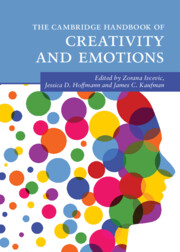Book contents
- The Cambridge Handbook of Creativity and Emotions
- Cambridge Handbooks in Psychology
- The Cambridge Handbook of Creativity and Emotions
- Copyright page
- Dedications
- Contents
- Figures
- Tables
- Contributors
- Acknowledgments
- Creativity and Emotions
- Part I Methods in the Study of Creativity and Emotions
- Part II The Development of Creativity
- 5 Affective States and Creativity
- 6 The Neuroscience of Creativity and Emotions
- 7 Attention, Affect, and Creativity, from Mindfulness to Mind-Wandering
- 8 Motivations, Emotions, and Creativity
- 9 Managing Difference and Uncertainty and Creativity
- 10 Creativity and Emotional Intelligence
- 11 Emotions across the Creative Process and across Domains of Creativity
- Part III Emotions and the Creative Person
- Part IV Emotions and Creative Products
- Part V Emotions and Creativity at School and Work
- Index
- References
7 - Attention, Affect, and Creativity, from Mindfulness to Mind-Wandering
from Part II - The Development of Creativity
Published online by Cambridge University Press: 16 February 2023
- The Cambridge Handbook of Creativity and Emotions
- Cambridge Handbooks in Psychology
- The Cambridge Handbook of Creativity and Emotions
- Copyright page
- Dedications
- Contents
- Figures
- Tables
- Contributors
- Acknowledgments
- Creativity and Emotions
- Part I Methods in the Study of Creativity and Emotions
- Part II The Development of Creativity
- 5 Affective States and Creativity
- 6 The Neuroscience of Creativity and Emotions
- 7 Attention, Affect, and Creativity, from Mindfulness to Mind-Wandering
- 8 Motivations, Emotions, and Creativity
- 9 Managing Difference and Uncertainty and Creativity
- 10 Creativity and Emotional Intelligence
- 11 Emotions across the Creative Process and across Domains of Creativity
- Part III Emotions and the Creative Person
- Part IV Emotions and Creative Products
- Part V Emotions and Creativity at School and Work
- Index
- References
Summary
This chapter explores the relationships between attention, affect, and creativity, including a discussion of creativity in the context of mindfulness and mind-wandering. First, we discuss the effects of different forms of attention on different types of creativity, such as divergent and convergent thinking, and real-world creative achievements. We then follow with a discussion of the relationship between creativity, emotional functioning, and the power of positivity on fostering creative ideas. The chapter concludes with a review on how mindfulness meditation and mind-wandering, both separately and jointly, impact creative thinking. This includes a discussion of the effects of different types of mindfulness meditation on creativity, as well as the core facets thought to constitute mindfulness. Overall, this chapter provides an engaging overview of the various attentional and emotional states thought to be implicated in creativity, as well as an intriguing look at how mindfulness and mind-wandering work independently and in tandem to influence creative thinking.
Keywords
- Type
- Chapter
- Information
- The Cambridge Handbook of Creativity and Emotions , pp. 130 - 148Publisher: Cambridge University PressPrint publication year: 2023
References
- 2
- Cited by

